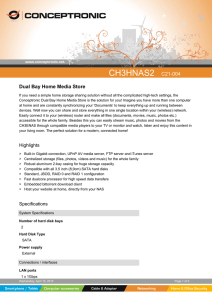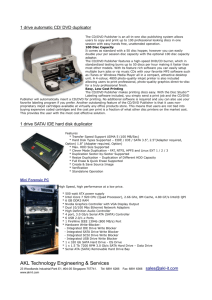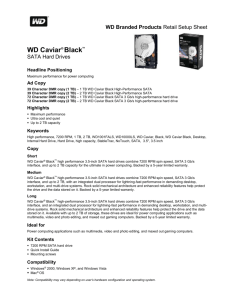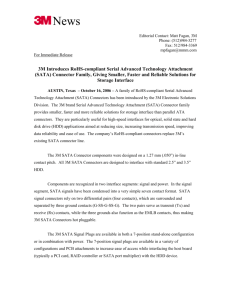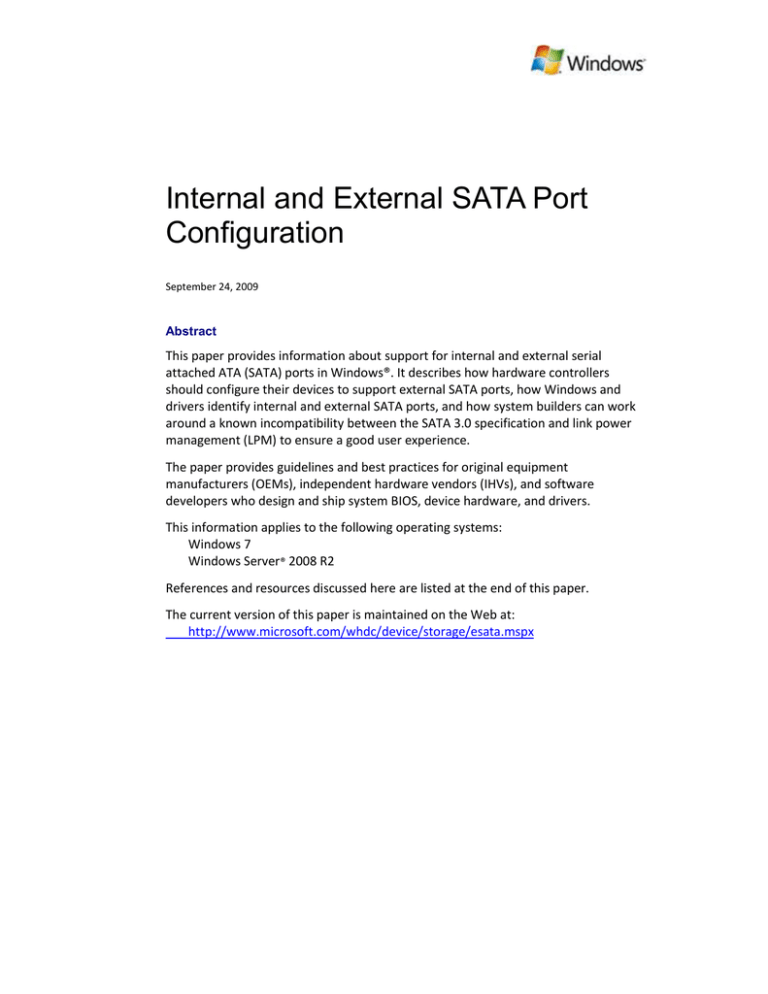
Internal and External SATA Port
Configuration
September 24, 2009
Abstract
This paper provides information about support for internal and external serial
attached ATA (SATA) ports in Windows®. It describes how hardware controllers
should configure their devices to support external SATA ports, how Windows and
drivers identify internal and external SATA ports, and how system builders can work
around a known incompatibility between the SATA 3.0 specification and link power
management (LPM) to ensure a good user experience.
The paper provides guidelines and best practices for original equipment
manufacturers (OEMs), independent hardware vendors (IHVs), and software
developers who design and ship system BIOS, device hardware, and drivers.
This information applies to the following operating systems:
Windows 7
Windows Server® 2008 R2
References and resources discussed here are listed at the end of this paper.
The current version of this paper is maintained on the Web at:
http://www.microsoft.com/whdc/device/storage/esata.mspx
Internal and External SATA Port Configuration - 2
Disclaimer: This is a preliminary document and may be changed substantially prior to final commercial
release of the software described herein.
The information contained in this document represents the current view of Microsoft Corporation on the
issues discussed as of the date of publication. Because Microsoft must respond to changing market
conditions, it should not be interpreted to be a commitment on the part of Microsoft, and Microsoft cannot
guarantee the accuracy of any information presented after the date of publication.
This White Paper is for informational purposes only. MICROSOFT MAKES NO WARRANTIES, EXPRESS,
IMPLIED OR STATUTORY, AS TO THE INFORMATION IN THIS DOCUMENT.
Complying with all applicable copyright laws is the responsibility of the user. Without limiting the rights under
copyright, no part of this document may be reproduced, stored in or introduced into a retrieval system, or
transmitted in any form or by any means (electronic, mechanical, photocopying, recording, or otherwise), or
for any purpose, without the express written permission of Microsoft Corporation.
Microsoft may have patents, patent applications, trademarks, copyrights, or other intellectual property rights
covering subject matter in this document. Except as expressly provided in any written license agreement
from Microsoft, the furnishing of this document does not give you any license to these patents, trademarks,
copyrights, or other intellectual property.
Unless otherwise noted, the example companies, organizations, products, domain names, e-mail addresses,
logos, people, places and events depicted herein are fictitious, and no association with any real company,
organization, product, domain name, email address, logo, person, place or event is intended or should be
inferred.
© 2009 Microsoft Corporation. All rights reserved.
Microsoft, Windows, and Windows Server are either registered trademarks or trademarks of Microsoft
Corporation in the United States and/or other countries.
The names of actual companies and products mentioned herein may be the trademarks of their respective
owners.
Document History
Date
September 24, 2009
Change
First publication
Contents
Introduction ................................................................................................................... 3
Characteristics of SATA Ports ......................................................................................... 3
Industry Standard SATA Requirements .......................................................................... 4
SATA Revision 3.0 Requirements ............................................................................... 4
Electrical and Mechanical Requirements for SATA Ports ...................................... 4
Hot-Plug Requirement ........................................................................................... 5
AHCI 1.3 Requirements .............................................................................................. 5
How Windows Identifies an External SATA Port ............................................................ 6
Design Issues for SATA Ports .......................................................................................... 6
Hot-Plug Event Detection and Power Management ................................................. 6
Incorrect SATA Configuration .................................................................................... 7
Best Practices ................................................................................................................. 8
Resources ....................................................................................................................... 8
September 24, 2009
© 2009 Microsoft Corporation. All rights reserved.
Internal and External SATA Port Configuration - 3
Introduction
Windows® supports both internal and external serial ATA (SATA) ports that comply
with the SATA Revision 3.0 Specification. External SATA ports are intended for
external storage applications, such as disk arrays, and electrical and mechanical
requirements that are different from the requirements for internal ports. Devices
that are attached to external SATA ports can be removed while the system is running,
but devices that are attached to internal SATA ports cannot.
Because external SATA devices are removable, external SATA ports require Plug and
Play settings and power settings that are different from the settings for internal SATA
ports. The system hardware configuration must correctly identify external SATA ports
so that Windows can apply the appropriate settings.
Some systems today incorrectly set the internal SATA port as an external SATA port,
which results in a poor user experience in Windows. This paper provides general
information for original equipment manufacturers (OEMs), independent hardware
vendors (IHVs), and driver developers on how to determine the current SATA
hardware configuration and how to work around an incorrect external SATA port
setting without changing the BIOS or system software. The paper covers the following
topics:
Characteristics of SATA ports.
Industry standard requirements for SATA ports.
How Windows identifies an external SATA port.
Design issues for SATA ports.
Best practices.
Characteristics of SATA Ports
A SATA port can be internal to the computer or can be externally accessible. All
externally accessible SATA ports—also called eSATA ports—must support hot-plug, so
that users can connect or disconnect external SATA devices while the system runs. An
external SATA port can provide a connector for either of the following:
Signal-only cable
Signal and power cable
Figure 1 (on the following page) shows the two types of eSATA ports in common
configurations.
External SATA ports that connect with a signal-only cable are commonly provided on
motherboards. Devices that connect to such ports must have a separate power cable.
In the removable bays on portable computers, the external SATA ports typically
support both signal and power connections. Devices that connect to these ports
receive power from the portable computer instead of from an external power source.
September 24, 2009
© 2009 Microsoft Corporation. All rights reserved.
Internal and External SATA Port Configuration - 4
SATA device
Signal cable only
Power cable
SATA device
Signal and power cable
Figure 1. Two types of external SATA ports
Industry Standard SATA Requirements
The following industry standards define SATA architecture and implementation:
SATA Revision 3.0 Specification.
Serial ATA Advanced Host Controller Interface (AHCI) 1.3 specification.
The SATA Revision 3.0 Specification, which is published by the Serial ATA
International Organization, defines the industry-standard architecture for both
internal and external SATA ports. The Serial ATA Advanced Host Controller Interface
(AHCI) 1.3 specification outlines AHCI, which is the most common programming
interface for SATA controllers.
This section describes the requirements that these two specifications impose on SATA
port design and implementation.
SATA Revision 3.0 Requirements
The SATA Revision 3.0 specification identifies the hardware features that are required
for SATA ports. The most significant features from a Windows perspective involve the
electrical and mechanical requirements and the hot-plug requirements.
Electrical and Mechanical Requirements for SATA Ports
Internal and external SATA ports have different electrical and mechanical
requirements. For details of the specifications for internal SATA ports, see
section 5.2.1 of the SATA 3.0 Specification, and for details of the specifications for
external SATA ports, see section 5.2.6 of the specification. Table 1 on the following
page summarizes the requirements.
September 24, 2009
© 2009 Microsoft Corporation. All rights reserved.
Internal and External SATA Port Configuration - 5
Table 1. Electrical and Mechanical Requirements for Internal and External SATA Ports
Characteristic
Internal
External
Cable and/or
Internal single-lane
External single-lane
backplane type
Cable length
<= 1 meter
<= 2 meters
Cable electrical
See Table 18, SATA Revision 3.0
See Table 19, SATA Revision 3.0
Specification.
Specification.
Attenuation at 4.5
-6 decibel (dB)
-8 dB
gigahertz (GHz)
Host-side connector
See section 6.1.5, SATA Revision
See section 6.5.1, SATA
3.0 Specification.
Revision 3.0 Specification.
Device-side
See section 6.1.3.1, SATA
See section 6.5.1, SATA
connector
Revision 3.0 Specification.
Revision 3.0 Specification.
Gen1i 1.5 gigabytes
Required
Not supported
per second (Gbps)
Gen1m 1.5 Gbps
Not supported
Required
Gen2i 3.0 Gbps1
Feature-specific
Not supported
Gen2m 3.0 Gbps1
Not supported
Feature-specific
Gen1x 1.5 Gbps
Not supported
Not supported
Gen 2x 3.0 Gbps
Not supported
Not supported
1
Gen 3i 6.0 Gbps
Feature-specific
Not supported
Hot-plug support
Not supported
Required
1
For external SATA port, Gen1 is required but higher data rates are optional.
Hot-Plug Requirement
The host system and the device enclosure must comply with the hot-plug
requirements SATA Revision 3.0 Specification. The specification describes the hotplug requirements as follows:
“When a Host or Device is declared Hot-Plug Capable without any qualifier, this
shall imply that the SATA interface is Surprise Hot-Plug Capable. For the purposes
of this specification, Hot-Plug operations are defined as insertion or removal
operations, between SATA hosts and devices, when either side of the interface is
powered.”
External SATA ports must support the Asynchronous Signal Hot Plug/Removal hotplug event. This event applies to external single-lane and multi-lane cabled
applications and occurs any time a signal cable is plugged or unplugged. Because the
power source is external to the signal cable, the specification requires that power to
the host/device remains on.
AHCI 1.3 Requirements
AHCI is the most common interface for host-bus adapters (also called SATA host
controllers) to communicate with their hardware and with system memory. Although
this paper mentions only AHCI, the concepts in this section also apply to other SATA
controller hardware architectures.
AHCI defines two models for connecting devices to externally accessible SATA ports:
signal cable-only connections and signal and power cable connections, as described in
“Characteristics of SATA Ports” earlier in this paper. Both types of connectors must
support hot-plug operations.
September 24, 2009
© 2009 Microsoft Corporation. All rights reserved.
Internal and External SATA Port Configuration - 6
To indicate that the hardware supports an external SATA port that has a signal-only
connector, the SATA controller sets the Support External SATA (SXS) bit to 1 in the
host bus adapter (HBA) capability register (CAP) of AHCI. The controller also sets the
external SATA port (ESP) bit in the Command/Status Register (PxCMD) of each
external SATA port x that has a signal-only connector. In short, if CAP.SXS and
PxCMD.ESP are both set to 1, the port has a signal-only connector.
To indicate that the external SATA port has a signal and power connector, the SATA
controller sets the hot-plug capable (HPCP) bit of the port’s PxCMD register to 1. It
does not set CAP.SXS to 1. In addition, the HPCP bit and the ESP bit in the same
register are mutually exclusive, according to the ACHI specification. That is, if ESP is
set in the register, HPCP must be clear, and conversely. By setting HPCP, the SATA
controller indicates that the port uses a single connector for both power and signal.
How Windows Identifies an External SATA Port
A Windows driver identifies an external SATA port by checking the register values of
the CAP.SXS and PxCMD.ESP registers. If the CAP.SXS bit is set to 1, the driver should
read the ESP bit of each port’s PxCMD register. If ESP is set to 1, the port has an
externally accessible signal-only connector. If ESP is cleared to 0 and PxCMD.HPCP is
set to 1, the port has a signal and power connector.
Regardless of the type of connector, Windows treats all devices that are connected to
eSATA ports as removable, hot-plug devices.
To discover and configure an external SATA port
1. Read the values of the AHCI registers to determine whether the port is external.
Consider the port external if either of the following is true:
PxCMD.HPCP is set to 1.
CAP.SXS and PxCMD.ESP are set to 1.
2. In response to the IRP_MN_QUERY_CAPABILITIES request to the PDO, set the
Removable member of the DEVICE_CAPABILITIES structure to TRUE if the device
is connected to an external port. This setting ensures that Windows displays the
device in the Safely Remove Device dialog box in the system tray.
Design Issues for SATA Ports
OEMs and IHVs must ensure that their products correctly identify and configure
internal and external SATA ports. This section describes two issues that commonly
affect SATA configurations and provides a workaround for each.
Hot-Plug Event Detection and Power Management
The SATA specification contains a known incompatibility between LPM and hot-plug
events. When a hot-plug event occurs, the SATA controller hardware detects the
event and reports it to Windows. However, if SATA LPM is enabled and the link is in a
low-power state, the controller hardware cannot detect the event.
September 24, 2009
© 2009 Microsoft Corporation. All rights reserved.
Internal and External SATA Port Configuration - 7
For the hot-plug function to work correctly, Windows power policy must disable LPM
for the external SATA port. The Microsoft-supplied ATAport miniport driver disables
LPM for such ports during Plug and Play enumeration.
Incorrect SATA Configuration
Incorrect SATA configuration can appear in the following situations:
If the system incorrectly identifies an internal SATA port as external, Windows
disables LPM on that port and therefore cannot conserve power to the port. In
addition, Windows treats the internal non-removable device that is connected to
that port as a removable device. For example, it appears in the Safely Remove
Device dialog box in the system tray and in Devices and Printers.
If an external SATA port is not correctly configured, it is possible for a device that
is connected to the port to be considered not removable and therefore to fail to
appear in the Safely Remove Device dialog box in the system tray and in Devices
and Printers.
If an internal SATA port is incorrectly configured as an external SATA port, a system
vendor or administrator can correct it without updating the system BIOS or the
Windows software.
To work around this problem, you can disable external SATA support on a perchannel basis by setting the value of the TreatAsInternalPort registry key to 1 and
then rebooting the system.
If the system has both internal and external SATA ports, but a device that is attached
to an internal SATA port appears in the Safely Remove Devices dialog box in the
system tray or in Devices and Printers, you should reset the registry key for the port.
For example, if only channel 2 is an actual external SATA port, but all four SATA ports
were set as external, the following commands set the ports correctly:
reg.exe add
"HKLM\SYSTEM\CurrentControlSet\Services\msahci\Controller0\Channel0" /f
/v TreatAsInternalPort /t REG_DWORD /d 0x00000001
reg.exe add
"HKLM\SYSTEM\CurrentControlSet\Services\msahci\Controller0\Channel1" /f
/v TreatAsInternalPort /t REG_DWORD /d 0x00000001
reg.exe add
"HKLM\SYSTEM\CurrentControlSet\Services\msahci\Controller0\Channel3" /f
/v TreatAsInternalPort /t REG_DWORD /d 0x00000001
The channel numbers that Device Manager shows might not match the channel
numbers in the registry. You might be required to set the value, reboot the system,
and verify that the appropriate port is set correctly. For more information, see “The
disk drive numbers may not correspond as expected to the SATA channel numbers
when you set up Windows Vista, Windows Server 2008, Windows Server 2008 R2, or
Windows 7 on a computer that has multiple SATA or RAID disks,” which is listed in
“Resources.”.
September 24, 2009
© 2009 Microsoft Corporation. All rights reserved.
Internal and External SATA Port Configuration - 8
Best Practices
This section summarizes best practices for system designers, hardware vendors, and
driver developers to ensure that their SATA hardware and drivers are compatible
with Windows.
For system designers:
Set a SATA port as external only if the port is designed for external connection
use and meets both the electrical and mechanical requirements of the
specification.
For hardware vendors:
Do not supply a cable adapter to convert an internal SATA port to an external
SATA port without correct BIOS setting.
This creates a mismatch between the hardware and software and causes
unwanted device behavior as described in this paper.
For storage driver developers:
Correctly identify external SATA ports and enable safe removal of any device that
is connected to such a port, as described in this paper. Windows considers any
device that is attached to an eSATA port to be removable.
Disable LPM on the external port unless the driver can correctly detect device
arrival and removal by using another method such as ACPI events.
Resources
SATA Revision 3.0 Specification
Serial ATA International Organization
www.sata-io.org
Serial ATA Advanced Host Controller Interface (AHCI) 1.3 specification
Intel Corporation
www.intel.com/technology/serialata/ahci.htm
The disk drive numbers may not correspond as expected to the SATA channel
numbers when you set up Windows Vista, Windows Server 2008, Windows Server
2008 R2, or Windows 7 on a computer that has multiple SATA or RAID disks
http://support.microsoft.com/kb/937251
September 24, 2009
© 2009 Microsoft Corporation. All rights reserved.

